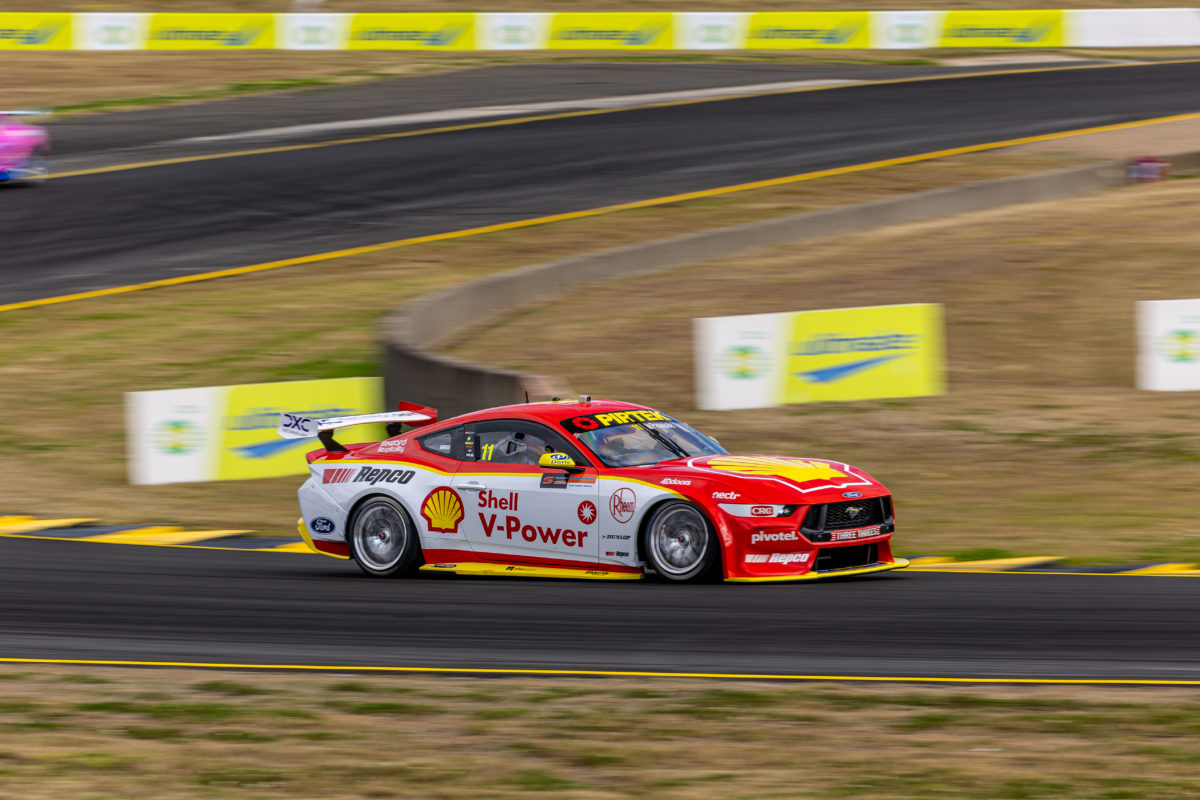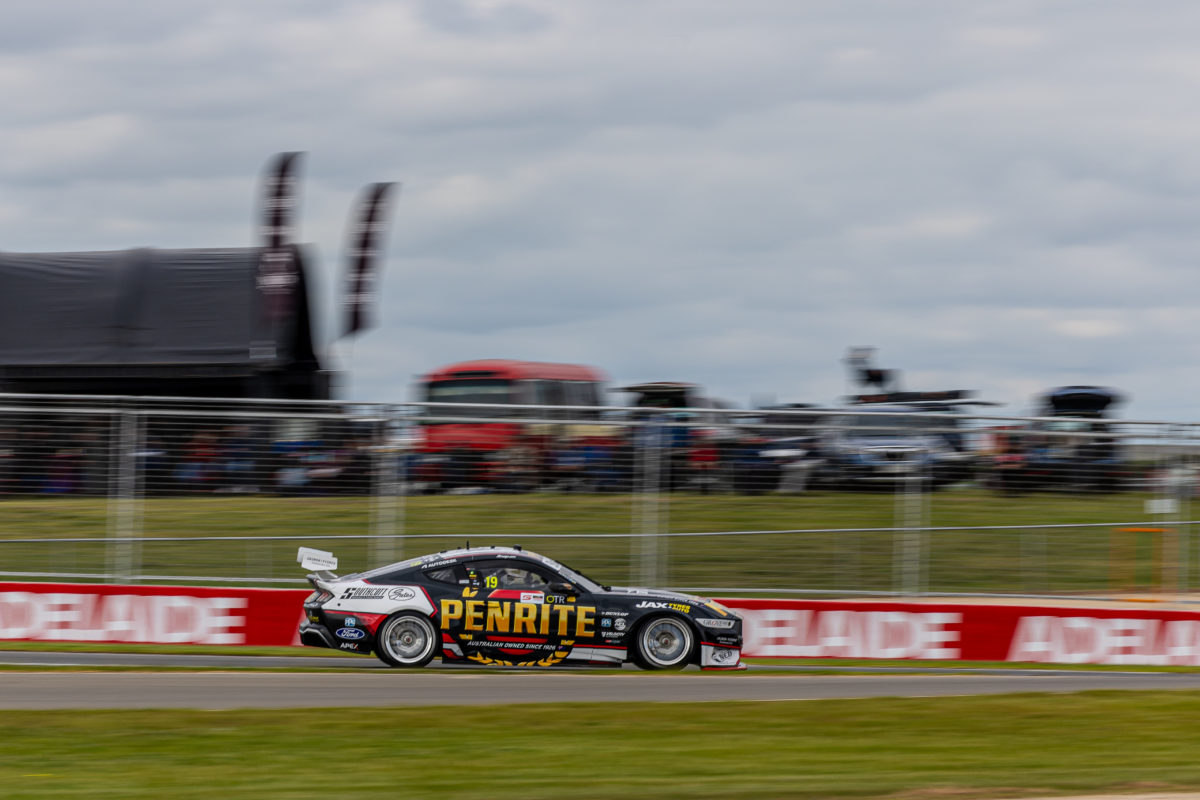

The Ford Mustang’s aerodynamics are back in focus after a post-event test at The Bend, and suggestions of a drag problem, but a surprise factor has now been uncovered.
That is, the gearstick.
Homologation team Dick Johnson Racing and fellow Ford Supercars squad Tickford Racing stayed on at The Bend on the Monday immediately following the OTR SuperSprint to undertake validation work different aerodynamic packages.
It is understood, though, that there will be no changes for the Sandown 500 at least.
That is because there have not been enough races to trigger an official parity review, based on the system as explained by Supercars last time around, since the latest Mustang bodywork was introduced at the NTI Townsville 500.
Instead, Speedcafe understands, the work which was undertaken at The Bend was a proactive exercise in case of a future parity review and/or rehomologation.
However, concerns remain about the competitiveness of the Blue Oval Supercar against the Chevrolet Camaro.
Tickford Team Principal Tim Edwards stated, after his squad led something of a Ford fightback at The Bend, that he is “fairly confident that there’s still issues.”
That comment came after Walkinshaw Andretti United Team Principal Bruce Stewart put drag on the agenda on the eve of track activity at the South Australian circuit, declaring it as “something, I think, anyone in a Mustang will be wary of.”
However, it has now become apparent that this ‘drag’ problem may well have been caused, if not wholly then substantially so, by a change to the shift cut delta between the Mustang and Camaro.
The shift cut is triggered automatically by the pull of the gearstick for an upshift, and hence the gearstick was, in a roundabout way, creating the (perception of) excessive drag from the Mustang.
To unravel this phenomenon, we have to wind the clock back to June, when the aforementioned parity review led to revised aero being introduced to the Mustangs from the NTI Townsville 500.
Total downforce, though, was supposed to remain the same.
Meanwhile, as teams and drivers tried to come to grips with the new aero package in North Queensland, the throttle body in the Coyote-derived Ford engine became a talking point.
That would lead to an 80mm throttle body being introduced to the Ford engine, bringing it into line with that of Chevrolet’s, rather than an 87mm unit.
The logic was that it would improve the driveability of the Mustang, even if DJR Team Principal Ben Croke forecast that the impact would be “minimal”.
Amid all of that, there were claims from Chevrolet figures such as Brad Jones Racing’s Macauley Jones that the Mustang’s straight-line speed, as demonstrated on the 1.1km stretch at Hidden Valley Raceway, is “not a problem.”
DJR’s Will Davison said during that Darwin weekend that the differences between the two cars were “interesting,” noting that the Chevrolet engine had a longer than standard 105ms shift cut versus the Ford’s 50ms (or as short as 30ms in some gears during some events), as an interim parity measure.
Whether because of the change of Ford throttle body or, as one source has told Speedcafe, an acknowledgement that the Mustang was in fact faster down a straight, a change to the Chevrolet shift cut was made for the Sydney Motorsport Park event.
Precise details are the subject of conjecture, but either version of the story points to the Camaro being made more competitive in a straight line.
One is that the Chevrolet was given an 80ms shift cut for SMP, while the other that Speedcafe has heard is that the two engines were equalised (or very close to) with respect to shift cut, except for the 80ms for the Chevrolet for changes to the top two gears.
To reiterate, that 80ms is still longer than the standard 50ms, but shorter than the installed 105ms cut which had been used since before the season began in Newcastle in March.
Naturally, then, the Camaros were faster down SMP’s long main straight, which was formerly used also as a drag strip, than they otherwise would have been.
It has been put to Speedcafe by a reliable source that it is in fact the change to the Chevrolet engine’s shift cut which created the impression of a drag problem, rather than necessarily being a function of aerodynamics.
Notably, WAU’s Chaz Mostert stated after three-stopping his way to the podium in Townsville that “it feels like we don’t really have a rear wing” on his Mobil 1 Optus Mustang.

Townsville’s Reid Park Street Circuit is, of course, not as aero-sensitive a track as SMP, and Ford teams were learning about their new package on the run, amid the noise of an actual or potential shortcoming of the 87mm throttle body.
Worth also considering is the fact that SMP was the first repeat circuit of the year in so much that the pre-season test was held there in February, when the Chevrolet engine’s 105ms cut was first installed.
While there was plenty of noise then as well – rain, variable tyre stocks, no minimum vehicle weight, and inexperience with Gen3 – one might wonder whether it was used as something of a baseline for the race event which unfolded in late-July.
However, changes to engine settings such as the shift cut are not necessarily disclosed up and down pit lane before implementation, and there is often a level of conjecture about what either model of vehicle may be running with, particularly from the Chevrolet camp looking at the Mustangs and vice versa.
According to Speedcafe’s intel, Ford teams did not know about the quicker Chevrolet shift cut in Sydney.
It is now understood that shift cuts have been set at 50ms for the Ford and 105ms again for the Chevrolet, settings which are expected to remain in place for the balance of the season, although that much can never be guaranteed.
Intriguingly, there are conflicting understandings about whether the Chevrolet engine had the sub-105ms shift cut(s) for the competitive sessions (qualifying, racing) at SMP or just for practice, although the former seems more likely to have been the case.
Notably, according to Speedcafe intel, a Supercars staff member hurriedly plugged laptops into all 14 Camaros just prior to Qualifying for Race 18 of the season at the Western Sydney circuit, after which specs such as engine map and shift cut have to be locked in (and consistent across each model) for the remainder of the event.
Croke made comments at the conclusion of racing at ‘Eastern Creek’ which were not inconsistent with the possibility of a change to the Chevrolet shift cut.
He remarked at the time, regarding parity, “They’ve [Supercars] obviously got a job, and everything from the other side as well – the GM side – to keep it even, but they hear us and they work with us. I think that’s been evidenced with some of the throttle body stuff that we’ve been able to do.
“But, I think the other side also got some map changes and some stuff going on for this weekend that I think improved their product that no one reported on.
“So, whilst there was all this talk about our throttle body, they got some improvements as well.”
What is not in dispute, so far as Speedcafe knows, is that the Camaros were back onto the 105ms cut at The Bend.
The state of affairs raises questions as to why the Mustangs were so much more competitive at The Bend, and what it all means for the enduros, given Sandown and Mount Panorama are both described as a pair of drag strips connected by some corners.
Theories abound, but Speedcafe has been told that The Bend is an ‘understeer track’, in so much that the frequency of long corners mean one is best served by dialling understeer into the car.
As such, The Bend’s layout may well play to the strengths of the package which is on the Mustang at present.
However, it has also been pointed out to Speedcafe that the shift cut measure is pure straight-line speed, and The Bend, like SMP and Hidden Valley, has a very long main straight.
Whatever the cause(s), if not for championship leader Brodie Kostecki and his Erebus Motorsport Camaro, Mustangs would have locked out the front row and swept the podium in all three races at The Bend.
The Bend and Bathurst have certain similarities, although the former is still a somewhat unique track on the Supercars calendar and thus the situation leaves room for pessimism from the Ford camp.
Adding to the sense of angst is that questions remain about the existence, or otherwise, of a transient disparity between the Ford and Chevrolet engines, with transient dynamometer running and installation of torque sensors yet to take place.
Still, while Ford teams are concerned about their package, so too is there worry within the Chevrolet camp, about what a 105ms shift cut means for them at a place such as Mount Panorama.
The same could be said for Sandown, where the first enduro event of the year takes place on September 15-17.





















Discussion about this post